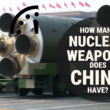Bringing a knife to a gunfight: biological weapons as deterrents in a nuclear-armed world
By Martin Furmanski, March 20, 2015
Seth Baum’s recent column, which called for legitimizing non-contagious biological weapons to replace the deterrent function of nuclear weapons, is problematic for me on a number of levels, but in this essay I will address only one: Would biological weapons be effective as weapons of deterrence, as potential replacements for some of the existing or future nuclear weapons?
The terrible destructive power of nuclear weapons is obvious: Hiroshima and Nagasaki demonstrated the power of first-generation fission warheads, and then, in the mid-20th century, atmospheric testing showed the even more awesome potential of augmented fission and true thermonuclear warheads, which can be tens and hundreds of times more powerful. Nuclear weapons can be delivered by a variety of systems, primitive or sophisticated, and are effective in any environment or weather, against essentially any target: cities, military bases, hardened underground bunkers, and mobile military assets such as naval battle groups.
Defenses against nuclear weapons are ineffective. The heat, blast, and ionizing radiation of nuclear explosions can only be survived in hardened underground facilities, and then only if those facilities are not specifically targeted. Mediation of radioactive fallout damage is localized and feeble at best. There is no way of reversing or ameliorating the biological and physical damage after the attack has occurred. The sole defense against nuclear weapon attack is total interdiction of its delivery systems, a goal that may be unattainable when a single failure results in unacceptable death and destruction.
In contrast, the effects of biological weapons are speculative and unproven. The alarming, well publicized models of the dire consequences of bioweapon attacks, resulting in mass casualties, are based on a number of important but undisclosed technical assumptions and typically portray a “most damaging case” scenario. While this type of estimation is prudent in making risk assessments, it has also been, historically, self-serving to those persons and institutions making the estimates, because careers and appropriations are dependent on convincing scientifically unsophisticated military and political authorities of the potential danger of biological weapons. When one examines the actual constraints of field use of biological weapons, as discovered during the US offensive bioweapons program, which lasted from 1942 to 1969, one discovers fundamental limitations.
Biological weapons potentially useful as strategic deterrents would be delivered by wide-area aerosols. The effectiveness of bioweapon aerosols is profoundly influenced not only by the agent preparation and delivery system, but also by a large number of independent factors, such as time of day, temperature, humidity, local landforms and vegetation, degree and type of urban development, atmospheric temperature gradients, and wind speed and direction. Each of these compounding variables can influence the ultimate effectiveness by several orders of magnitude, so that unfavorability of even a few variables will render an aerosol attack ineffective. A deterrent weapon must offer the assurance of an immediate, effective retaliatory attack under conditions not of the defending nation’s choosing. Biological weapons cannot give this assurance.
Real-world biological targets offer considerable resistance to bioweapon effects, when compared to field tests on animals in cages. The modern filtration in air-handling systems in typical late 20th- and 21st-century buildings and vehicles significantly reduces the effectiveness of biological aerosols. Moreover, bioweapon agents are, after all, biological, and show biological frailty. They are exquisitely vulnerable to industrial type air pollution, an effect noted by United Kingdom investigators at Porton Down, when mid-20th century England was still burning soft coal. Much of China and many Asian and other cities in the developing world today would be similarly resistant to an aerosol bioweapon attack. These fundamental limitations on the practical employment of biological weapons were well known on an operational level during the US offensive bioweapon program, and are responsible for the distinct lack of enthusiasm for biological weapons by any branch of the US armed forces, except for the sponsoring Chemical Corps. Soldiers require weapons that will function as expected in the environment in which they find themselves fighting, when they are wanted and needed. Biological weapons cannot meet this requirement.
Biological weapons are vulnerable to both pre-attack and post-attack defenses. Preemptive immunization would nullify the deterrent effect of a biological agent, and this has already been done by the US military in the case of anthrax and smallpox. In a true threat scenario, or to nullify another nation’s deterrent, mass immunization of the entire population could be undertaken: The US Strategic National Stockpile was created with this in mind. Such emergency mass immunization programs have been undertaken in non bioweapon-threat scenarios: The ill-fated 1976 swine flu immunization program immunized 40 million people in three months.
Biological weapon effects can be nullified or mitigated after the attack with post-exposure treatment. This had been evaluated experimentally in humans during the US offensive bioweapon program, but was most dramatically demonstrated in the 2001 postal anthrax attacks. At the Senate office building the threat was immediately recognized, and exposed personnel were given post-exposure antibiotics immediately. No cases occurred in that cohort. At two postal centers, the exposure was not immediately appreciated, and seven unexpected symptomatic inhalation cases developed. These first cases appeared in personnel who worked closest to the automated letter-handling machines that generated the aerosols, and who therefore received the highest dose. Upon recognition of the postal center exposures, all potentially exposed employees were put on post-exposure antibiotics. Only two of the seven symptomatic postal cases died, far less than the 90 percent fatality rate predicted before the experience with post-exposure antimicrobial therapy. Quite remarkably, no further cases appeared among postal personnel after the institution of post-exposure antimicrobial therapy, even though the 1979 Sverdlovsk anthrax accident in the Soviet Union and animal studies predicted new cases would continue to appear for 60 to 90 days. Post-exposure therapy truncated the attack effects as soon as it was recognized.
To be a credible strategic deterrent, a weapon needs to offer assured unacceptable damage when used in retaliation against an enemy’s attack. Nuclear weapons are credible. Biological weapons, not so much.
Share: [addthis tool="addthis_inline_share_toolbox"]














